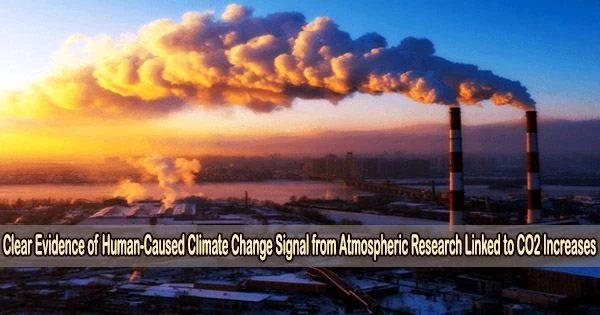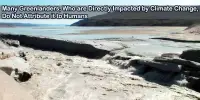A new body of research reveals that unique signals from human activities have changed the temperature structure of Earth’s atmosphere and establishes a definite human “fingerprint” on climate change.
Long acknowledged as a fingerprint of anthropogenic climate change, differences in tropospheric and lower stratospheric temperature trends are still present today. However, this fingerprint ignored data from the mid to upper stratosphere, about 25 to 50 kilometers above the surface of the Earth.
“Including this information improves the detectability of a human fingerprint by a factor of five. Enhanced detectability occurs because the mid to upper stratosphere has a large cooling signal from human-caused CO2 increases, small noise levels of natural internal variability, and differing signal and noise patterns,” according to the journal article, “Exceptional stratospheric contribution to human fingerprints on atmospheric temperature,” published in the Proceedings of the National Academy of Sciences (PNAS).
Noise in the troposphere can include day-to-day weather, interannual variability arising from El Niños and La Niñas, and longer-term natural fluctuations in climate. In the upper stratosphere, the signal of human-caused climate change is stronger and more easily distinguishable due to lower levels of fluctuation noise.
“Extending fingerprinting to the upper stratosphere with long temperature records and improved climate models means that it is now virtually impossible for natural causes to explain satellite-measured trends in the thermal structure of the Earth’s atmosphere,” the paper states.
“This is the clearest evidence there is of a human-caused climate change signal associated with CO2 increases,” according to lead author Benjamin Santer, an adjunct scientist in the Physical Oceanography Department at the Woods Hole Oceanographic Institute (WHOI) in Massachusetts.
“This research undercuts and rebuts claims that recent atmospheric and surface temperature changes are natural, whether due to the Sun or due to internal cycles in the climate system. A natural explanation is virtually impossible in terms of what we are looking at here: changes in the temperature structure of the atmosphere,” added Santer, who has worked on climate fingerprinting for more than 30 years. “This research puts to rest incorrect claims that we don’t need to treat climate change seriously because it is all natural.”
This study shows that the real world has changed in a way that simply cannot be explained by natural causes. We now face important decisions, in the United States and globally, on what to do about climate change. I hope those decisions are based on our best scientific understanding of the reality and seriousness of human effects on climate.
Benjamin Santer
The research was motivated by earlier work by Suki Manabe and Richard Wetherald, who in 1967 used a simple climate model to study how CO2 from fossil fuel burning might change atmospheric temperature.
Their modeling found a very distinctive feature: an increase in CO2 levels led to more trapping of heat in the troposphere (the lowest layer of Earth’s atmosphere) and less heat escaping higher up into the stratosphere (the layer above the troposphere), thus warming the troposphere and cooling the stratosphere.
More complicated models have repeatedly corroborated this prediction of stratospheric cooling and tropospheric warming in response to rising CO2, and model findings have been compared with observations of the global-mean air temperature made by weather balloons and satellites.
Although the global-mean temperature increases in the middle and upper stratosphere, which are located 25 to 50 kilometers above Earth’s surface, were taken into consideration in these earlier research, more in-depth patterns of climate change in this layer were not examined.
This region can be better studied now because of improved simulations and satellite data. The new study is the first to look for “fingerprints” of human-caused climate change in the middle and high stratosphere.
“The human fingerprints in temperature changes in the mid to upper stratosphere due to CO2 increases are truly exceptional because they are so large and so different from temperature changes there due to internal variability and natural external forcing. These unique fingerprints make it possible to detect the human impact on climate change due to CO2 in a short period of time (~10 – 15 years) with high confidence,” stated co-author Qiang Fu, a professor in the Department of Atmospheric Sciences at the University of Washington.
“The world has been reeling under climate change, so being as confident as possible of the role of carbon dioxide is critical,” said co-author Susan Solomon, Martin Professor of Environmental Studies at the Massachusetts Institute of Technology. “The fact that observations show not only a warming troposphere but also a strongly cooling upper stratosphere is unique tell-tale evidence that nails the dominant role of carbon dioxide in climate change and greatly increases confidence.”
Santer said that although it is intellectually gratifying to be able to extend fingerprinting higher up into the atmosphere to test the prediction by Manabe and Wetherald, it is also deeply concerning.
“As someone who tries to understand the kind of world that future generations are going to inhabit, these results make me very worried. We are fundamentally changing the thermal structure of Earth’s atmosphere, and there is no joy in recognizing that,” Santer said.
“This study shows that the real world has changed in a way that simply cannot be explained by natural causes,” Santer added. “We now face important decisions, in the United States and globally, on what to do about climate change. I hope those decisions are based on our best scientific understanding of the reality and seriousness of human effects on climate.”
National Science Foundation, National Oceanic and Atmospheric Administration, U.S. Department of Energy, and the Francis E. Fowler IV Center provided funding for the study for Ocean and Climate at Woods Hole Oceanographic Institution.
















